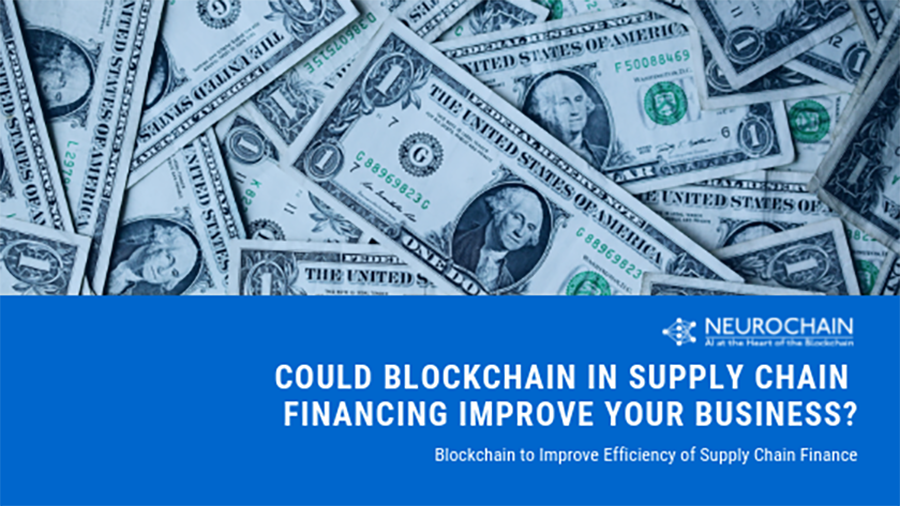The primary function of a supply chain is to facilitate exchange between a buyer and a seller to transform resources into a valuable product for the final customer. Demand for a product originates from the final customer at the top of the supply chain and cascades down through retailers, manufacturers, and suppliers. In an ideal supply chain network, consumer demand for a product would prompt the retailer to place an order with the manufacturer, who in turn places an order for parts and raw materials from the suppliers. The manufacturer would pay the supplier for the order and would manufacture the product. The retailer would then pay for the order, and a carrier would deliver the order to retailers. However, in real-world supply chain networks, the cash flow from buyer to seller is not always cut and dry.
The term supply chain finance comes from the need to finance the production of the product from the bottom-up. When consumer demand prompts a buyer to place an order, the seller may not have the cash flow to produce the order. The seller must pay overhead, labor and material costs to fulfill an order. A study found that over 20% of businesses use supply chain financing and the majority of companies using supply chain financing are small and medium-sized enterprises (SMEs). To gain a practical understanding of the role supply chain finance plays, let’s assume that you are the supply chain manager for a flat-screen TV manufacturing company. You just received an order from a nationwide retailer for 10,000 TVs. Each TV requires electronics, a screen, a frame, a base, and packaging. The TVs are assembled down an assembly line, requiring several employees to perform various functions. You are still waiting on payments from outstanding invoices, and until you receive payment, you do not have the cash on hand to pay for the overhead, labor, and materials. This is where supply chain finance plays an important role.

Supply chain finance occurs when a financial institution, such as a bank, buys the seller’s receivables (outstanding invoices) at a discounted rate to increase the seller’s working capital and mitigate supply chain inefficiencies. In exchange for the financing, the financial institution charges discount fees (similar to interest rates) and credit management fees. Depending on the arrangement, the financial institution may also charge credit protection fees in case the buyer defaults.
While there are several methods of supply chain financing, each with slightly different processes, risks and liabilities, the most popular financing method is known as reverse factoring. The term reverse factoring is often used interchangeably with supply chain financing. The reverse factoring transaction flow occurs as follows:
1) The buyer places an order with the seller and initiates the financing process.
2) The seller invoices the buyer and provides a copy to the financial institution.
3) The financial institution pays 80% – 90% of the invoice to the seller.
4) The seller fulfills the order and delivers to the buyer.
5) The buyer pays the invoice by the due date (typically 30 days after delivery). The buyer usually pays the financial institution directly.
6) The financial institution pays the remaining 10% – 20% of the invoice to the seller minus financing fees.
As with any extension of credit, reverse factoring comes with certain risks if the buyer defaults. Depending on the terms of the financing agreement, the financial institution may or may not take on the risk if the buyer defaults. Agreements in which the financial institution does not assume the risk is known as a recourse agreement, while ones in which risk is assumed are called non-recourse agreements. Regardless, the financial institution maintains a level of transparency over both the seller and the buyer.
While the applications of blockchain technology to improve the supply chain functions is currently being explored, one of the less studied uses of blockchain is its ability to facilitate supply chain finance. Blockchain is a distributed, digital ledger in which all parties involved in the transaction can access the records, but transactions cannot be altered or deleted. Blockchain supports the deployment of smart contracts, which are self-executing contracts triggered by the completion of predetermined events.

Here are the ways that blockchain technology will improve supply chain finance:
Increased Trust Between Buyers, Sellers, and Financial Institutions
Blockchain inherently increases trust between all of the parties involved because an immutable ledger is shared amongst all parties. A distributed network prevents a single party from having too much control. In supply chain finance, blockchain increases trust between buyers, sellers, and financial institutions. Buyers rely on sellers will deliver quality, authentic products. Sellers rely on buyers to pay the invoice by the due date. Financial institutions rely on both the buyers and sellers to execute the purchase agreement and reclaim the advance. Typically, supply chains have multiple buyers, sellers, and financial institutions involved, directly and indirectly affecting each other. Trust between parties is imperative to managing an efficient supply chain.
Intelligent Security
Blockchain derives its trust from its security algorithm, also known as a consensus protocol. A consensus protocol is a procedure used to validate transactions and create new blocks of the blockchain. While each blockchain uses its own consensus protocol, the Proof of Involvement and Integrity (PII) consensus protocol, developed by NeuroChain, is by far the most secure. The PII protocol uses Machine Learning and Artificial Intelligence to validate transactions. Blockchain also prevents records from being erased or altered.
Prevent Supply Chain Disruption
Supply chain disruptions can occur when a seller does not have the resources or current cash flow to fulfill a buyer’s order. The seller must obtain supply chain financing to produce the order and meet current demand. Therefore, supply chain financing keeps the supply chain running smoothly; however, when supply chain financing is distrusted, the supply chain is affected as a result. There are inherent risks involved in supply chain financing. The most frequent risk occurs when the buyer defaults on the payment of goods already delivered. This may be due to a change in demand (not being able to sell the product), poor financial management, or fraud. Blockchain addresses each of these problems. While changes in demand can be caused by several factors, extended time-series data, and consumer buying cycles tend to be reasonably accurate in predicting demand. Using blockchain to store historical demand data ensures the integrity of the data. Smart contracts are used to ensure the buyer transfers the outstanding balance to the financial institution by the due date.

Automated Transactions Through Smart Contracts
Smart contracts can be used to automate all of the transactions laid out in a reverse factoring agreement. The smart contract is entered into by the buyer, seller, and financial institution. Here is an example of a smart contract execution of a reverse factoring supply chain finance agreement:
1) The buyer, seller, and financial institution enter into a reverse factoring agreement.
2) The agreement is converted into a smart contract, and the contract is deployed on the blockchain.
3) The seller sends an invoice to the buyers in advance for the order.
4) When the buyer approves the order, the specified payment is automatically debited from the buyer’s wallet and stored in the blockchain.
5) Upon successful completion of the previous step, the smart contact automatically debits the specified amount (usually 80% – 90% of the invoiced amount) from the financial institution’s wallet and credits the seller’s wallet.
6) The seller uses the financing to produce the product. Typically, withdraws from the seller’s wallet must be used directly to fulfill the buyer’s order.
7) The seller delivers the order to the buyer, and the buyer approves the delivery.
8) Upon approval, the smart contract releases the remaining 10% – 20% of the invoice to the seller from the financial institution’s wallet minus applicable financing fees.
9) On the invoice due date, the financial intuition automatically receives the payment from the buyer that was stored in the smart contract.
Ready to Use Blockchain and Smart Contracts in Supply Chain Finance?
NeuroChain is the next generation of blockchain technology that is powered by machine learning and artificial intelligence. Unlike competitor blockchains, NeuroChain is truly decentralized, scalable, and energy efficient. To learn how NeuroChain can power your smart business applications, take a look at this article.
NeuroChain, let’s build a better world!
Photo credits: Unsplash, Pixabay
Follow us on Telegram, Facebook, Twitter and YouTube. If you have any questions, feel free to get in touch with NeuroChain Team, and we will answer you as soon as possible!
